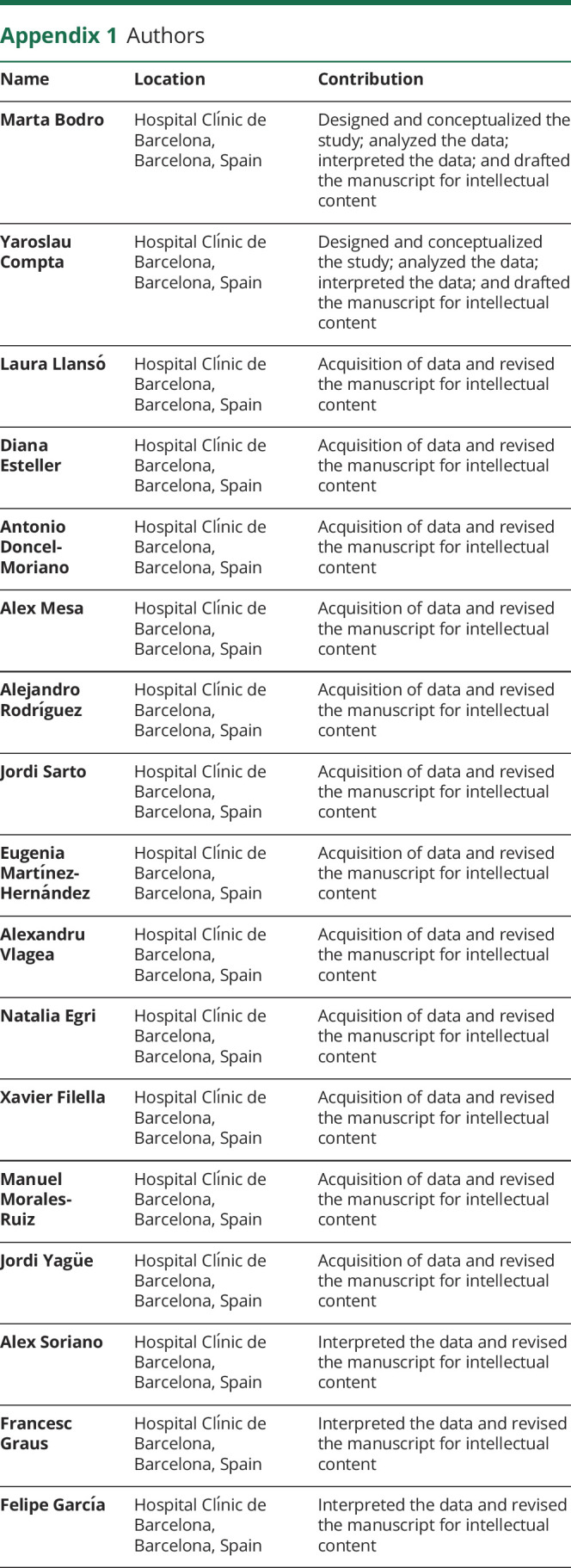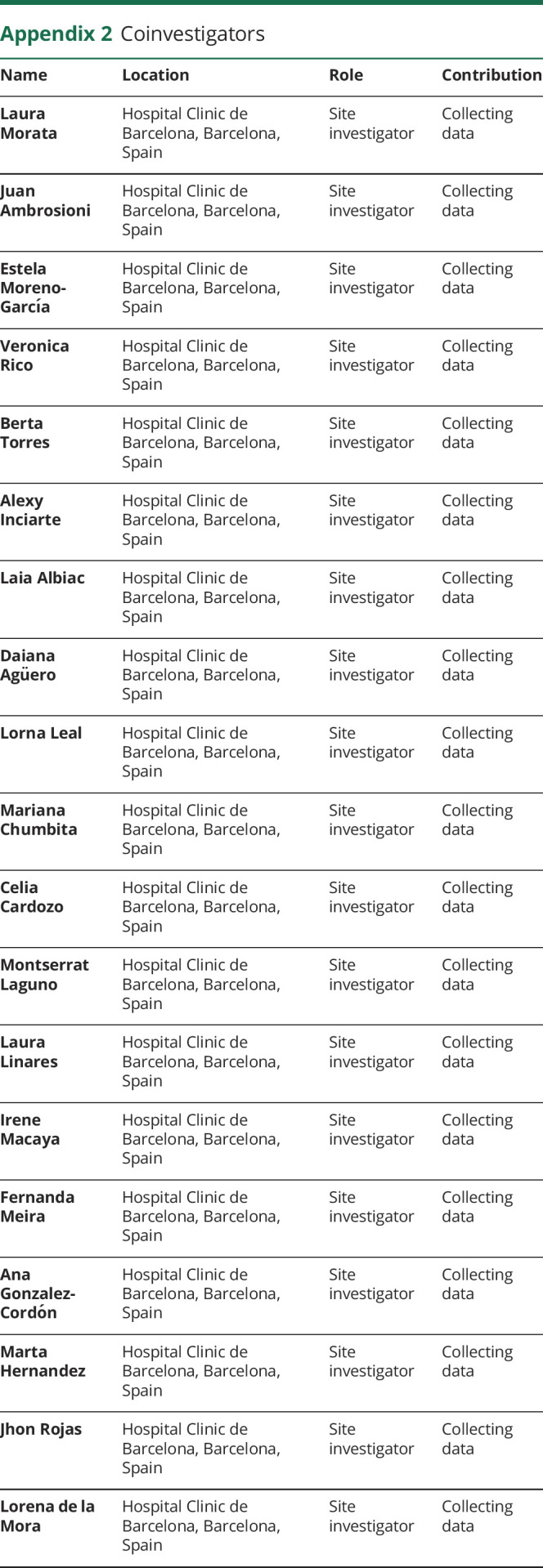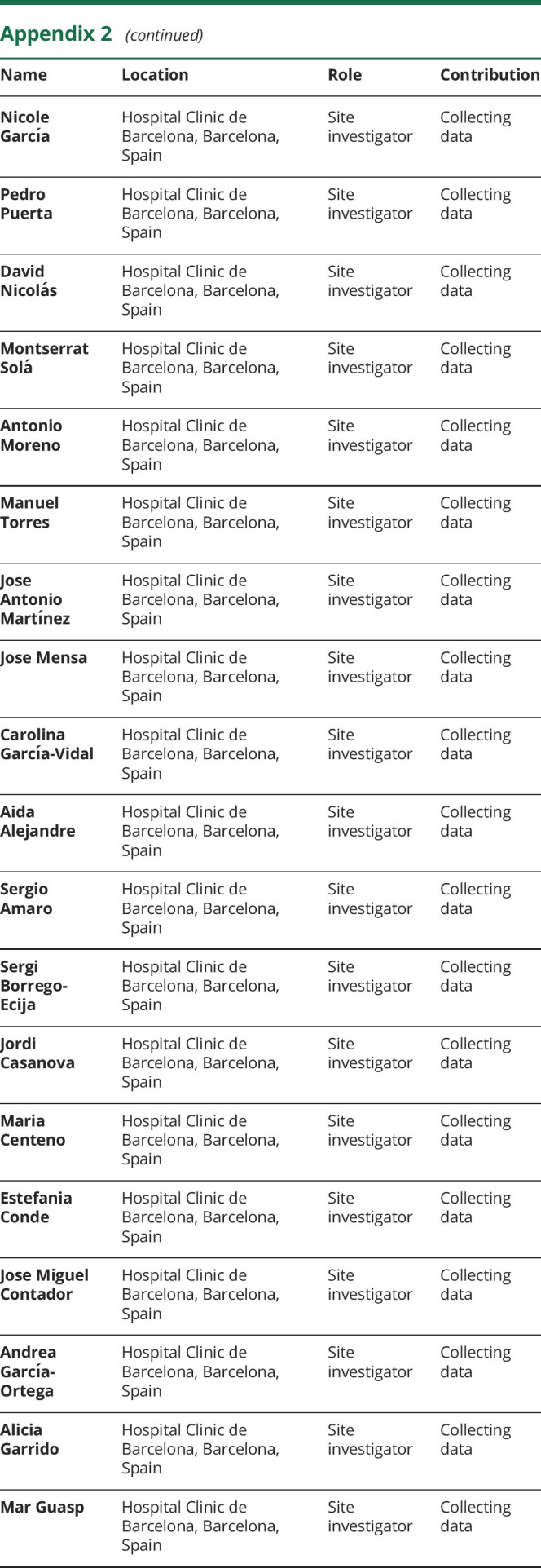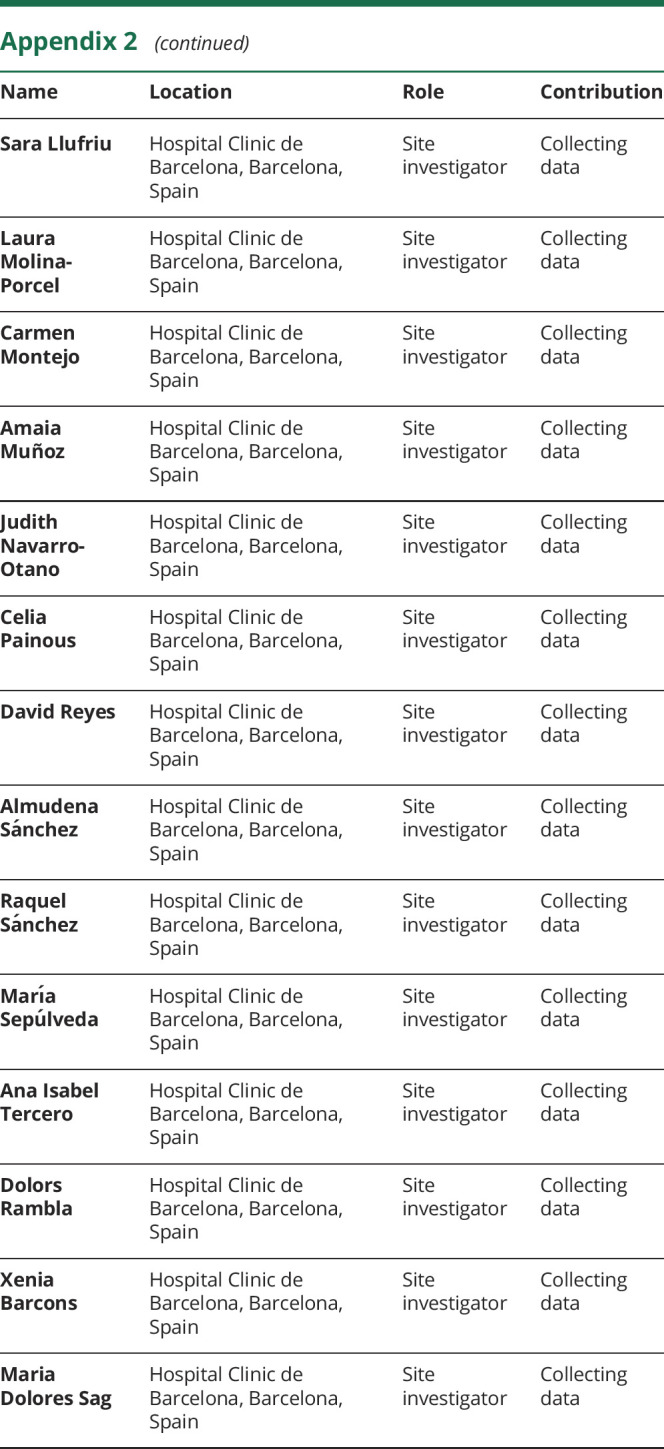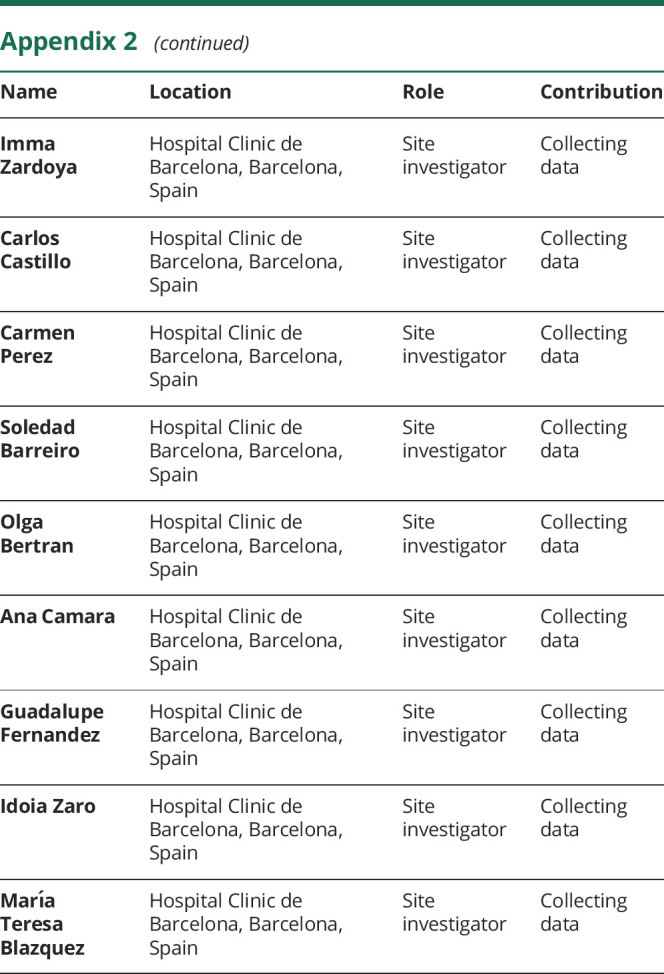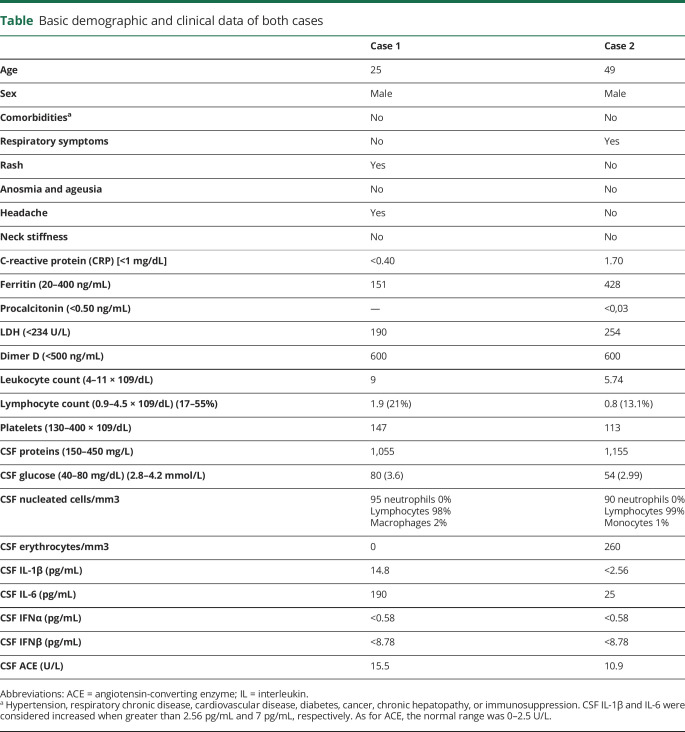Marta Bodro
Marta Bodro, MD, PhD
1From the Infectious Diseases Service (M.B., Á.S., F. García), Hospital Clínic de Barcelona, Catalonia; Institut d'Investigacions Biomèdiques August Pi i Sunyer (IDIBAPS) (M.B., Y.C., X.F., M.M.-R., J.Y., Á.S., F. Graus, F. García), Barcelona, Catalonia; Department of Medicine (M.B., Y.C., Á.S., F. García), Universitat de Barcelona, Catalonia; Neurology Service (Y.C., L.L., D.E., A.D.-M., A.R., J.S.), Hospital Clínic de Barcelona, Catalonia; Institut de Neurociències (Y.C.), Maria de Maeztu excellence center, Universitat de Barcelona, Catalonia; Endocrinology and Nutricion Service (A.M.), Hospital Clínic de Barcelona, Catalonia; Immunology Service (A.V., N.E., J.Y.), Centre de Diagnòstic Biomèdic (CDB), Hospital Clínic de Barcelona, Functional Unit of Clinical Immunology, Hospital Sant Joan de Déu & Hospital Clínic, Barcelona, Catalonia; CDB (X.F., M.M.-R.), Hospital Clínic de Barcelona, Barcelona, Catalonia; and Department of Biomedicine (M.M.-R.), Universitat de Barcelona; CIBERehd; Catalonia, Spain.
1,*,✉,
Yaroslau Compta
Yaroslau Compta, MD, PhD
1From the Infectious Diseases Service (M.B., Á.S., F. García), Hospital Clínic de Barcelona, Catalonia; Institut d'Investigacions Biomèdiques August Pi i Sunyer (IDIBAPS) (M.B., Y.C., X.F., M.M.-R., J.Y., Á.S., F. Graus, F. García), Barcelona, Catalonia; Department of Medicine (M.B., Y.C., Á.S., F. García), Universitat de Barcelona, Catalonia; Neurology Service (Y.C., L.L., D.E., A.D.-M., A.R., J.S.), Hospital Clínic de Barcelona, Catalonia; Institut de Neurociències (Y.C.), Maria de Maeztu excellence center, Universitat de Barcelona, Catalonia; Endocrinology and Nutricion Service (A.M.), Hospital Clínic de Barcelona, Catalonia; Immunology Service (A.V., N.E., J.Y.), Centre de Diagnòstic Biomèdic (CDB), Hospital Clínic de Barcelona, Functional Unit of Clinical Immunology, Hospital Sant Joan de Déu & Hospital Clínic, Barcelona, Catalonia; CDB (X.F., M.M.-R.), Hospital Clínic de Barcelona, Barcelona, Catalonia; and Department of Biomedicine (M.M.-R.), Universitat de Barcelona; CIBERehd; Catalonia, Spain.
1,*,✉,
Laura Llansó
Laura Llansó, MD
1From the Infectious Diseases Service (M.B., Á.S., F. García), Hospital Clínic de Barcelona, Catalonia; Institut d'Investigacions Biomèdiques August Pi i Sunyer (IDIBAPS) (M.B., Y.C., X.F., M.M.-R., J.Y., Á.S., F. Graus, F. García), Barcelona, Catalonia; Department of Medicine (M.B., Y.C., Á.S., F. García), Universitat de Barcelona, Catalonia; Neurology Service (Y.C., L.L., D.E., A.D.-M., A.R., J.S.), Hospital Clínic de Barcelona, Catalonia; Institut de Neurociències (Y.C.), Maria de Maeztu excellence center, Universitat de Barcelona, Catalonia; Endocrinology and Nutricion Service (A.M.), Hospital Clínic de Barcelona, Catalonia; Immunology Service (A.V., N.E., J.Y.), Centre de Diagnòstic Biomèdic (CDB), Hospital Clínic de Barcelona, Functional Unit of Clinical Immunology, Hospital Sant Joan de Déu & Hospital Clínic, Barcelona, Catalonia; CDB (X.F., M.M.-R.), Hospital Clínic de Barcelona, Barcelona, Catalonia; and Department of Biomedicine (M.M.-R.), Universitat de Barcelona; CIBERehd; Catalonia, Spain.
1,
Diana Esteller
Diana Esteller, MD
1From the Infectious Diseases Service (M.B., Á.S., F. García), Hospital Clínic de Barcelona, Catalonia; Institut d'Investigacions Biomèdiques August Pi i Sunyer (IDIBAPS) (M.B., Y.C., X.F., M.M.-R., J.Y., Á.S., F. Graus, F. García), Barcelona, Catalonia; Department of Medicine (M.B., Y.C., Á.S., F. García), Universitat de Barcelona, Catalonia; Neurology Service (Y.C., L.L., D.E., A.D.-M., A.R., J.S.), Hospital Clínic de Barcelona, Catalonia; Institut de Neurociències (Y.C.), Maria de Maeztu excellence center, Universitat de Barcelona, Catalonia; Endocrinology and Nutricion Service (A.M.), Hospital Clínic de Barcelona, Catalonia; Immunology Service (A.V., N.E., J.Y.), Centre de Diagnòstic Biomèdic (CDB), Hospital Clínic de Barcelona, Functional Unit of Clinical Immunology, Hospital Sant Joan de Déu & Hospital Clínic, Barcelona, Catalonia; CDB (X.F., M.M.-R.), Hospital Clínic de Barcelona, Barcelona, Catalonia; and Department of Biomedicine (M.M.-R.), Universitat de Barcelona; CIBERehd; Catalonia, Spain.
1,
Antonio Doncel-Moriano
Antonio Doncel-Moriano, MD
1From the Infectious Diseases Service (M.B., Á.S., F. García), Hospital Clínic de Barcelona, Catalonia; Institut d'Investigacions Biomèdiques August Pi i Sunyer (IDIBAPS) (M.B., Y.C., X.F., M.M.-R., J.Y., Á.S., F. Graus, F. García), Barcelona, Catalonia; Department of Medicine (M.B., Y.C., Á.S., F. García), Universitat de Barcelona, Catalonia; Neurology Service (Y.C., L.L., D.E., A.D.-M., A.R., J.S.), Hospital Clínic de Barcelona, Catalonia; Institut de Neurociències (Y.C.), Maria de Maeztu excellence center, Universitat de Barcelona, Catalonia; Endocrinology and Nutricion Service (A.M.), Hospital Clínic de Barcelona, Catalonia; Immunology Service (A.V., N.E., J.Y.), Centre de Diagnòstic Biomèdic (CDB), Hospital Clínic de Barcelona, Functional Unit of Clinical Immunology, Hospital Sant Joan de Déu & Hospital Clínic, Barcelona, Catalonia; CDB (X.F., M.M.-R.), Hospital Clínic de Barcelona, Barcelona, Catalonia; and Department of Biomedicine (M.M.-R.), Universitat de Barcelona; CIBERehd; Catalonia, Spain.
1,
Alex Mesa
Alex Mesa, MD
1From the Infectious Diseases Service (M.B., Á.S., F. García), Hospital Clínic de Barcelona, Catalonia; Institut d'Investigacions Biomèdiques August Pi i Sunyer (IDIBAPS) (M.B., Y.C., X.F., M.M.-R., J.Y., Á.S., F. Graus, F. García), Barcelona, Catalonia; Department of Medicine (M.B., Y.C., Á.S., F. García), Universitat de Barcelona, Catalonia; Neurology Service (Y.C., L.L., D.E., A.D.-M., A.R., J.S.), Hospital Clínic de Barcelona, Catalonia; Institut de Neurociències (Y.C.), Maria de Maeztu excellence center, Universitat de Barcelona, Catalonia; Endocrinology and Nutricion Service (A.M.), Hospital Clínic de Barcelona, Catalonia; Immunology Service (A.V., N.E., J.Y.), Centre de Diagnòstic Biomèdic (CDB), Hospital Clínic de Barcelona, Functional Unit of Clinical Immunology, Hospital Sant Joan de Déu & Hospital Clínic, Barcelona, Catalonia; CDB (X.F., M.M.-R.), Hospital Clínic de Barcelona, Barcelona, Catalonia; and Department of Biomedicine (M.M.-R.), Universitat de Barcelona; CIBERehd; Catalonia, Spain.
1,
Alejandro Rodríguez
Alejandro Rodríguez, MD
1From the Infectious Diseases Service (M.B., Á.S., F. García), Hospital Clínic de Barcelona, Catalonia; Institut d'Investigacions Biomèdiques August Pi i Sunyer (IDIBAPS) (M.B., Y.C., X.F., M.M.-R., J.Y., Á.S., F. Graus, F. García), Barcelona, Catalonia; Department of Medicine (M.B., Y.C., Á.S., F. García), Universitat de Barcelona, Catalonia; Neurology Service (Y.C., L.L., D.E., A.D.-M., A.R., J.S.), Hospital Clínic de Barcelona, Catalonia; Institut de Neurociències (Y.C.), Maria de Maeztu excellence center, Universitat de Barcelona, Catalonia; Endocrinology and Nutricion Service (A.M.), Hospital Clínic de Barcelona, Catalonia; Immunology Service (A.V., N.E., J.Y.), Centre de Diagnòstic Biomèdic (CDB), Hospital Clínic de Barcelona, Functional Unit of Clinical Immunology, Hospital Sant Joan de Déu & Hospital Clínic, Barcelona, Catalonia; CDB (X.F., M.M.-R.), Hospital Clínic de Barcelona, Barcelona, Catalonia; and Department of Biomedicine (M.M.-R.), Universitat de Barcelona; CIBERehd; Catalonia, Spain.
1,
Jordi Sarto
Jordi Sarto, MD
1From the Infectious Diseases Service (M.B., Á.S., F. García), Hospital Clínic de Barcelona, Catalonia; Institut d'Investigacions Biomèdiques August Pi i Sunyer (IDIBAPS) (M.B., Y.C., X.F., M.M.-R., J.Y., Á.S., F. Graus, F. García), Barcelona, Catalonia; Department of Medicine (M.B., Y.C., Á.S., F. García), Universitat de Barcelona, Catalonia; Neurology Service (Y.C., L.L., D.E., A.D.-M., A.R., J.S.), Hospital Clínic de Barcelona, Catalonia; Institut de Neurociències (Y.C.), Maria de Maeztu excellence center, Universitat de Barcelona, Catalonia; Endocrinology and Nutricion Service (A.M.), Hospital Clínic de Barcelona, Catalonia; Immunology Service (A.V., N.E., J.Y.), Centre de Diagnòstic Biomèdic (CDB), Hospital Clínic de Barcelona, Functional Unit of Clinical Immunology, Hospital Sant Joan de Déu & Hospital Clínic, Barcelona, Catalonia; CDB (X.F., M.M.-R.), Hospital Clínic de Barcelona, Barcelona, Catalonia; and Department of Biomedicine (M.M.-R.), Universitat de Barcelona; CIBERehd; Catalonia, Spain.
1,
Eugenia Martínez-Hernandez
Eugenia Martínez-Hernandez, MD, PhD
1From the Infectious Diseases Service (M.B., Á.S., F. García), Hospital Clínic de Barcelona, Catalonia; Institut d'Investigacions Biomèdiques August Pi i Sunyer (IDIBAPS) (M.B., Y.C., X.F., M.M.-R., J.Y., Á.S., F. Graus, F. García), Barcelona, Catalonia; Department of Medicine (M.B., Y.C., Á.S., F. García), Universitat de Barcelona, Catalonia; Neurology Service (Y.C., L.L., D.E., A.D.-M., A.R., J.S.), Hospital Clínic de Barcelona, Catalonia; Institut de Neurociències (Y.C.), Maria de Maeztu excellence center, Universitat de Barcelona, Catalonia; Endocrinology and Nutricion Service (A.M.), Hospital Clínic de Barcelona, Catalonia; Immunology Service (A.V., N.E., J.Y.), Centre de Diagnòstic Biomèdic (CDB), Hospital Clínic de Barcelona, Functional Unit of Clinical Immunology, Hospital Sant Joan de Déu & Hospital Clínic, Barcelona, Catalonia; CDB (X.F., M.M.-R.), Hospital Clínic de Barcelona, Barcelona, Catalonia; and Department of Biomedicine (M.M.-R.), Universitat de Barcelona; CIBERehd; Catalonia, Spain.
1,
Alexandru Vlagea
Alexandru Vlagea, MD, PhD
1From the Infectious Diseases Service (M.B., Á.S., F. García), Hospital Clínic de Barcelona, Catalonia; Institut d'Investigacions Biomèdiques August Pi i Sunyer (IDIBAPS) (M.B., Y.C., X.F., M.M.-R., J.Y., Á.S., F. Graus, F. García), Barcelona, Catalonia; Department of Medicine (M.B., Y.C., Á.S., F. García), Universitat de Barcelona, Catalonia; Neurology Service (Y.C., L.L., D.E., A.D.-M., A.R., J.S.), Hospital Clínic de Barcelona, Catalonia; Institut de Neurociències (Y.C.), Maria de Maeztu excellence center, Universitat de Barcelona, Catalonia; Endocrinology and Nutricion Service (A.M.), Hospital Clínic de Barcelona, Catalonia; Immunology Service (A.V., N.E., J.Y.), Centre de Diagnòstic Biomèdic (CDB), Hospital Clínic de Barcelona, Functional Unit of Clinical Immunology, Hospital Sant Joan de Déu & Hospital Clínic, Barcelona, Catalonia; CDB (X.F., M.M.-R.), Hospital Clínic de Barcelona, Barcelona, Catalonia; and Department of Biomedicine (M.M.-R.), Universitat de Barcelona; CIBERehd; Catalonia, Spain.
1,
Natalia Egri
Natalia Egri, MD
1From the Infectious Diseases Service (M.B., Á.S., F. García), Hospital Clínic de Barcelona, Catalonia; Institut d'Investigacions Biomèdiques August Pi i Sunyer (IDIBAPS) (M.B., Y.C., X.F., M.M.-R., J.Y., Á.S., F. Graus, F. García), Barcelona, Catalonia; Department of Medicine (M.B., Y.C., Á.S., F. García), Universitat de Barcelona, Catalonia; Neurology Service (Y.C., L.L., D.E., A.D.-M., A.R., J.S.), Hospital Clínic de Barcelona, Catalonia; Institut de Neurociències (Y.C.), Maria de Maeztu excellence center, Universitat de Barcelona, Catalonia; Endocrinology and Nutricion Service (A.M.), Hospital Clínic de Barcelona, Catalonia; Immunology Service (A.V., N.E., J.Y.), Centre de Diagnòstic Biomèdic (CDB), Hospital Clínic de Barcelona, Functional Unit of Clinical Immunology, Hospital Sant Joan de Déu & Hospital Clínic, Barcelona, Catalonia; CDB (X.F., M.M.-R.), Hospital Clínic de Barcelona, Barcelona, Catalonia; and Department of Biomedicine (M.M.-R.), Universitat de Barcelona; CIBERehd; Catalonia, Spain.
1,
Xavier Filella
Xavier Filella, MD, PhD
1From the Infectious Diseases Service (M.B., Á.S., F. García), Hospital Clínic de Barcelona, Catalonia; Institut d'Investigacions Biomèdiques August Pi i Sunyer (IDIBAPS) (M.B., Y.C., X.F., M.M.-R., J.Y., Á.S., F. Graus, F. García), Barcelona, Catalonia; Department of Medicine (M.B., Y.C., Á.S., F. García), Universitat de Barcelona, Catalonia; Neurology Service (Y.C., L.L., D.E., A.D.-M., A.R., J.S.), Hospital Clínic de Barcelona, Catalonia; Institut de Neurociències (Y.C.), Maria de Maeztu excellence center, Universitat de Barcelona, Catalonia; Endocrinology and Nutricion Service (A.M.), Hospital Clínic de Barcelona, Catalonia; Immunology Service (A.V., N.E., J.Y.), Centre de Diagnòstic Biomèdic (CDB), Hospital Clínic de Barcelona, Functional Unit of Clinical Immunology, Hospital Sant Joan de Déu & Hospital Clínic, Barcelona, Catalonia; CDB (X.F., M.M.-R.), Hospital Clínic de Barcelona, Barcelona, Catalonia; and Department of Biomedicine (M.M.-R.), Universitat de Barcelona; CIBERehd; Catalonia, Spain.
1,
Manuel Morales-Ruiz
Manuel Morales-Ruiz, MD, PhD
1From the Infectious Diseases Service (M.B., Á.S., F. García), Hospital Clínic de Barcelona, Catalonia; Institut d'Investigacions Biomèdiques August Pi i Sunyer (IDIBAPS) (M.B., Y.C., X.F., M.M.-R., J.Y., Á.S., F. Graus, F. García), Barcelona, Catalonia; Department of Medicine (M.B., Y.C., Á.S., F. García), Universitat de Barcelona, Catalonia; Neurology Service (Y.C., L.L., D.E., A.D.-M., A.R., J.S.), Hospital Clínic de Barcelona, Catalonia; Institut de Neurociències (Y.C.), Maria de Maeztu excellence center, Universitat de Barcelona, Catalonia; Endocrinology and Nutricion Service (A.M.), Hospital Clínic de Barcelona, Catalonia; Immunology Service (A.V., N.E., J.Y.), Centre de Diagnòstic Biomèdic (CDB), Hospital Clínic de Barcelona, Functional Unit of Clinical Immunology, Hospital Sant Joan de Déu & Hospital Clínic, Barcelona, Catalonia; CDB (X.F., M.M.-R.), Hospital Clínic de Barcelona, Barcelona, Catalonia; and Department of Biomedicine (M.M.-R.), Universitat de Barcelona; CIBERehd; Catalonia, Spain.
1,
Jordi Yagüe
Jordi Yagüe, MD, PhD
1From the Infectious Diseases Service (M.B., Á.S., F. García), Hospital Clínic de Barcelona, Catalonia; Institut d'Investigacions Biomèdiques August Pi i Sunyer (IDIBAPS) (M.B., Y.C., X.F., M.M.-R., J.Y., Á.S., F. Graus, F. García), Barcelona, Catalonia; Department of Medicine (M.B., Y.C., Á.S., F. García), Universitat de Barcelona, Catalonia; Neurology Service (Y.C., L.L., D.E., A.D.-M., A.R., J.S.), Hospital Clínic de Barcelona, Catalonia; Institut de Neurociències (Y.C.), Maria de Maeztu excellence center, Universitat de Barcelona, Catalonia; Endocrinology and Nutricion Service (A.M.), Hospital Clínic de Barcelona, Catalonia; Immunology Service (A.V., N.E., J.Y.), Centre de Diagnòstic Biomèdic (CDB), Hospital Clínic de Barcelona, Functional Unit of Clinical Immunology, Hospital Sant Joan de Déu & Hospital Clínic, Barcelona, Catalonia; CDB (X.F., M.M.-R.), Hospital Clínic de Barcelona, Barcelona, Catalonia; and Department of Biomedicine (M.M.-R.), Universitat de Barcelona; CIBERehd; Catalonia, Spain.
1,
Álex Soriano
Álex Soriano, MD, PhD
1From the Infectious Diseases Service (M.B., Á.S., F. García), Hospital Clínic de Barcelona, Catalonia; Institut d'Investigacions Biomèdiques August Pi i Sunyer (IDIBAPS) (M.B., Y.C., X.F., M.M.-R., J.Y., Á.S., F. Graus, F. García), Barcelona, Catalonia; Department of Medicine (M.B., Y.C., Á.S., F. García), Universitat de Barcelona, Catalonia; Neurology Service (Y.C., L.L., D.E., A.D.-M., A.R., J.S.), Hospital Clínic de Barcelona, Catalonia; Institut de Neurociències (Y.C.), Maria de Maeztu excellence center, Universitat de Barcelona, Catalonia; Endocrinology and Nutricion Service (A.M.), Hospital Clínic de Barcelona, Catalonia; Immunology Service (A.V., N.E., J.Y.), Centre de Diagnòstic Biomèdic (CDB), Hospital Clínic de Barcelona, Functional Unit of Clinical Immunology, Hospital Sant Joan de Déu & Hospital Clínic, Barcelona, Catalonia; CDB (X.F., M.M.-R.), Hospital Clínic de Barcelona, Barcelona, Catalonia; and Department of Biomedicine (M.M.-R.), Universitat de Barcelona; CIBERehd; Catalonia, Spain.
1,
Francesc Graus
Francesc Graus, MD, PhD
1From the Infectious Diseases Service (M.B., Á.S., F. García), Hospital Clínic de Barcelona, Catalonia; Institut d'Investigacions Biomèdiques August Pi i Sunyer (IDIBAPS) (M.B., Y.C., X.F., M.M.-R., J.Y., Á.S., F. Graus, F. García), Barcelona, Catalonia; Department of Medicine (M.B., Y.C., Á.S., F. García), Universitat de Barcelona, Catalonia; Neurology Service (Y.C., L.L., D.E., A.D.-M., A.R., J.S.), Hospital Clínic de Barcelona, Catalonia; Institut de Neurociències (Y.C.), Maria de Maeztu excellence center, Universitat de Barcelona, Catalonia; Endocrinology and Nutricion Service (A.M.), Hospital Clínic de Barcelona, Catalonia; Immunology Service (A.V., N.E., J.Y.), Centre de Diagnòstic Biomèdic (CDB), Hospital Clínic de Barcelona, Functional Unit of Clinical Immunology, Hospital Sant Joan de Déu & Hospital Clínic, Barcelona, Catalonia; CDB (X.F., M.M.-R.), Hospital Clínic de Barcelona, Barcelona, Catalonia; and Department of Biomedicine (M.M.-R.), Universitat de Barcelona; CIBERehd; Catalonia, Spain.
1,
Felipe García
Felipe García, MD, PhD
1From the Infectious Diseases Service (M.B., Á.S., F. García), Hospital Clínic de Barcelona, Catalonia; Institut d'Investigacions Biomèdiques August Pi i Sunyer (IDIBAPS) (M.B., Y.C., X.F., M.M.-R., J.Y., Á.S., F. Graus, F. García), Barcelona, Catalonia; Department of Medicine (M.B., Y.C., Á.S., F. García), Universitat de Barcelona, Catalonia; Neurology Service (Y.C., L.L., D.E., A.D.-M., A.R., J.S.), Hospital Clínic de Barcelona, Catalonia; Institut de Neurociències (Y.C.), Maria de Maeztu excellence center, Universitat de Barcelona, Catalonia; Endocrinology and Nutricion Service (A.M.), Hospital Clínic de Barcelona, Catalonia; Immunology Service (A.V., N.E., J.Y.), Centre de Diagnòstic Biomèdic (CDB), Hospital Clínic de Barcelona, Functional Unit of Clinical Immunology, Hospital Sant Joan de Déu & Hospital Clínic, Barcelona, Catalonia; CDB (X.F., M.M.-R.), Hospital Clínic de Barcelona, Barcelona, Catalonia; and Department of Biomedicine (M.M.-R.), Universitat de Barcelona; CIBERehd; Catalonia, Spain.
1,
on behalf of the “Hospital Clínic Infecto-COVID-19” and “Hospital Clínic Neuro-COVID-19” groups
